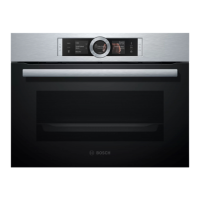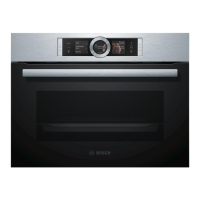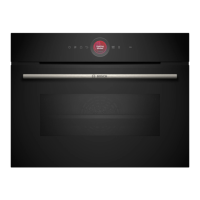en Tested for you in our cooking studio
36
Changing and cancelling
After starting the appliance, the settings can no longer
be changed.
If you would like to cancel the operation, switch the
appliance off using the ÿ On/Off button. You can no
longer pause the operation using the l Start/Stop
button.
JTested for you in our
cooking studio
Test ed f or y ou in our c ooki ng s t udi o
Here, you can find a selection of dishes and the ideal
settings for them. We will show you which type of
heating and temperature are best suited to your dish.
You will get information on suitable cooking
accessories and the height at which they should be
placed in the oven. You will also get tips about
cookware and preparation methods.
Note: A lot of steam can build up in the cooking
compartment when cooking food.
Your appliance is very energy-efficient and radiates very
little heat to its surroundings during operation. Due to
the high difference in temperature between the
appliance interior and the external parts of the
appliance, condensation may build up on the door,
control panel or adjacent kitchen cabinet panels. This is
a normal physical phenomenon. Condensation can be
reduced by preheating the oven or opening the door
carefully.
When steaming or during operation with steam
assistance, it is desirable that there is a significant
build-up of steam in the cooking compartment. Wipe the
cooking compartment clean after cooking, once it has
cooled off.
Silicone moulds
For the best cooking results, we recommend dark-
coloured metal baking tins/dishes.
Nevertheless, if you wish to use silicone moulds, follow
the manufacturer's instructions and recipes. Silicone
moulds are often smaller than normal baking tins.
Quantity and recipe specifications may vary.
Silicone moulds are unsuitable for steam-assisted
cooking and steaming.
Baking
Here, you can find recommended settings for many
dishes.
Also refer to the notes in the section on allowing dough
to rise.
Only use original accessories supplied with your
appliance. These have been tailored to the cooking
compartment and the operating modes of your
appliance.
Steam- assisted baking
Certain types of baked item (e.g. yeast-risen pastries)
get a more crispy crust and a more glossy surface if
baked with the steam assist mode. The baked item
does not dry out as much.
Steam-assisted baking is only possible on one level.
Some food turns out better if it is baked in several
stages. These dishes are indicated in the table.
Shelf positions
Use the indicated shelf positions.
Baking on one level
When baking on one level, use the following shelf
position:
■ Level 1
Baking on two levels
Use 4D hot air. Baked items that are placed into the
oven on trays or in baking tins/dishes at the same time
will not necessarily be ready at the same time.
■ Universal pan: Level 3
Baking tray: Level 1
■ Baking tins/dishes on the wire rack
First wire rack: Level 3
Second wire rack: Level 1
By preparing several dishes at the same time, you can
make energy savings of up to 45 per cent. Position
baking tins/dishes next to one another or offset and
vertically stacked in the cooking compartment.
Accessories
Ensure that you always use suitable accessories and
that they are placed in the oven the right way around.
Wire rack
Insert the wire rack with the open side facing the
appliance door and the curved lip pointing downwards.
Always place ovenware, tins and dishes on the wire
rack.
Universal pan or baking tray
Slide the universal pan or the baking tray in carefully as
far as the limit stop with the bevelled edge facing the
appliance door.
When baking moist cakes or pastries with many
toppings, use the universal pan so that any excess
liquid does not overflow and make the cooking
compartment dirty.
Baking tins
Dark- coloured metal baking tins are most suitable.
Tinplate baking tins, ceramic dishes and glass dishes
extend baking time and mean that the baked item will
not brown evenly.
The baking tins must be resistant to heat and steam for
use in steam-assisted baking.
Greaseproof paper
Only use greaseproof paper that is suitable for the
selected temperature. Always cut greaseproof paper to
size.
Recommended setting values
The table lists the optimal heating type for various
baked items. The temperature and baking time depend
Tested for you in our cooking studio en
37
on the amount and consistency of the dough/mixture.
For this reason, the table specifies setting ranges. Try
using the lower values to start with. A lower temperature
will result in more even browning. You can use a higher
setting next time if necessary.
Note: Baking times cannot be reduced by using higher
temperatures. Cakes or small baked items would only
be cooked on the outside, and would not be fully baked
in the middle.
The setting values apply to food that is placed into a
cold cooking compartment; by doing this, you can
make energy savings of up to 20 per cent.If you preheat
the oven, you can reduce the indicated baking times by
several minutes.
Preheating is necessary for selected food, and this is
indicated in the table. Do not place your food or
accessories into the cooking compartment until it has
finished preheating.
If you wish to follow one of your own recipes when
baking, you should use the setting values listed for
similar baked items in the table as reference.Additional
information can be found in the baking tips listed after
the settings table.
Remove unused accessories from the cooking
compartment. This will ensure that you achieve the best
possible cooking results and energy savings of up to
20 per cent.
Types of heating used:
■ < 4D hot air
■ $ Pizza setting
■ S Steaming
The levels of steam intensity are indicated as numbers
in the table:
■ 1 = Low
■ 2 = Medium
■ 3 = High
Dish Accessories/cookware Shelf po-
sition
Type of
heating
Tempera-
ture in °C
Steam in-
tensity
Cooking
time in mins.
One level baking
Victoria sponge cake 2x Ø20 cm tins 1 < 160-170* - 20-30
Victoria sponge cake 2x Ø20 cm tins 1 < 150-160 1 25-35
Light fruit cake high Ø20cm tin 1 < 140-160 - 70-90
Light fruit cake high Ø20 cm tin 1 < 140-150 1 90-100
Rich Fruit Cake high Ø23cm tin 1 < 130-150 - 150-180
Fruit crumble flat glass dish 2 < 150-170* - 30-45
Sponge Cake (fatless), 3 eggs springform cake tin, Ø26 cm 1 < 160-170* - 25-35
Sponge Cake (fatless), 3 eggs springform cake tin, Ø26 cm 1 < 150-160 1 10
- 25-35
Sponge flan, 6 eggs springform cake tin, Ø28 cm 1 < 150-170* - 30-50
Sponge flan, 6 eggs springform cake tin, Ø28 cm 1 < 150-160 1 10
- 30-35
Swiss Roll swiss roll tin 2 < 180-190* - 10-18
Swiss Roll swiss roll tin 2 < 180-190* 1 10-15
Fruit Pie plate Ø20cm or pie tin 1 $ 180-190 - 45-50
Quiche quiche tin (dark coated) 1 $ 190-210 - 30-45
(White) Bread loaf tin (1x 900 g or 2x 450 g) 1 < 190-210* - 20-30
(White) Bread loaf tin (1x 900 g or 2x 450 g) 1 < 210-220 3 10-15
180-190 - 25-35
Scones baking tray 1 < 180-200* - 10-14
Biscuits baking tray 2 < 140-160* - 10-25
Small cakes 12-cup-tin 1 < 140-160* - 20-35
Puff pastry slices baking tray 2 < 170-190* - 20-45
Puff pastry slices baking tray 1 < 210-220* 1 15-25
Jam tarts 12-cup-tin 2 < 160-180* - 15-30
Meringue baking tray 2 < 90-100* - 100-130
Pavlova baking tray 2 < 90-100* - 120-180
Soufflé 1,2 L-soufflé dish 1 < 160-170* - 40-50
Soufflé 1,2 L-soufflé dish 1 < 170-180 2 35-45
* Preheat

